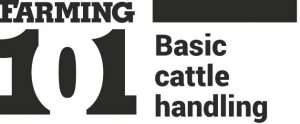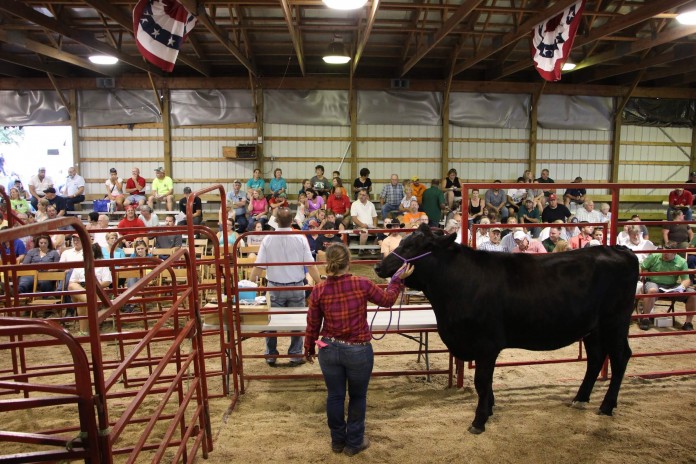“Stockmanship is setting cattle up to do what you want them to do,” said Steve Cote, who shared some basic tips for low-stress cattle handling during the North Central Ohio Grazing Conference.
Cote served as a soil and range conservationist for USDA for 27 years teaching stockmanship and range management.

1Stockmanship defined
Try out these best practices to improve your cattle handling:
- Use techniques stock respond to naturally.
- Stop forcing, only let cattle do what you want.
- Stop doing things that bother stock so they can respond calmly.
2Cattle traits
Cattle need a good leader. Someone who is calm and in full command. “Don’t be tentative around cattle,” said Cote. Cattle want to know what we want, and they want to see what is pressuring them to move.
3What not to do
Don’t shove or force cattle and don’t make loud noises to move them. This stresses them out. Don’t crowd or jam cattle when moving them. Don’t follow directly behind them — move from side to side so the cows can see you. And don’t move to quickly.
4What to do
Remain calm around livestock. Animals learn things in small steps. Once they learn where you want them to go and move in the direction you want, ease up. Be persistent, but not aggressive.
5What we want cattle to do
When cattle have been trained well they should allow the farmer close enough to handle them, and they should pass by the farmers at a walk (not a run).
They should move straight ahead at a good walk and keep going. Cattle should speed up and slow down based on your movements.
Cattle should turn in the opposite direction when the farmer steps wide to the side of the herd.
They should sort well, move from field to field or pen to pen, and load on to trailers easily.
6Stress
If you practice good stockmanship cattle will become less stressed and feel more calm and secure. This will lead to less health issues, such as respiratory diseases and foot rot. Cattle will eat more which increases their production. They will also move from place to place with little force.
For more on livestock handling, visit cotestockmanship.com.
(Farm and Dairy is featuring a series of “101” columns throughout the year to help young and beginning farmers master farm living. From finances to management to machinery repair and animal care, farmers do it all.)
More Farming 101 columns:
- Should I buy a new or used tractor?
- How to inspect a used tractor before purchase
- How to buy the right tractor for your farm
- 5 tips for a better farm marketing plan
- How to seek help with retirement planning
- How to set goals for retirement
- A farmer’s guide to saving for retirement
- A farmer’s guide to planning for retirement
- 5 steps to get NRCS assistance
- How can conservation easements help you?
- How to fund conservation plans
- What is a conservation plan?
- How can NRCS help you?
- More airborne hazards on the farm
- 5 airborne hazards to beware of on the farm
- 5 things to know about Wagyu beef
- Pennsylvania utility vehicle laws
- Ohio utility vehicle laws
- Farm chemical safety checklist
- When should a farm become a business entity?
- Harvest prep: Check your yield monitors
- How to tag livestock properly
- 6 tips for decision making on a family farm
- 8 tips to prepare your farm for agritourism
- How to plan for farm emergencies
- 7 keys to success on the farm
- 7 tips for healthy fair animals
- 5 tips to ensure livestock health before the fair
- 6 tips to keep your livestock parasite free
- 6 tips for vaccinating your livestock
- 5 tips to prevent dairy cow foot problems
- 6 common foot problems found in dairy cows
- Recognize, prevent heat stress in dairy cattle
- How to monitor your dairy herd
- How to start your own dairy farm
- 5 tips for sun safety in the field
- Employing youth for the summer
- What to do if a hay fire occurs
- How to prevent hay fires
- How to extend the life of your fence
- 10 safety tips for installing electric fences
- How to chose the right fence for your farm
- How to create a fencing plan
- 7 steps for easy sprayer calibration
- Prepare for planting season, Part 2: Calibration
- Prepare for planting season, Part 1: The Basics
- 7 tips to improve security on your farm
- 5 tips to protect your farmland
- 3 measures to deal with severe farm debt
- How to buy time to catch up on farm debt
- 6 tips to manage income on the farm
- 5 tips to recognize and deal with farm stress
- How to prepare a livestock birthing kit
- 5 tips for marketing your farm
- How to develop farm mission, vision statements
- 5 tips for setting farm goals
- 2 types of livestock insurance policies
- 6 things you need to know about WFRP plans
- 3 basics of crop insurance
- How does liability insurance work on the farm?
- Why do I need farm insurance?
- How to understand and use Ohio’s CAUV
- How to utilize the Pa. Clean and Green Act
- 9 tips for filing farm taxes
- 8 reasons record keeping for taxes is essential
- 5 tips for post-harvest storage
- 7 tips for family meetings on the farm
- 4 tips for balancing your farm and family
- 4 tips for communicating on the family farm
- 4 tips for firing an employee
- 6 tips for keeping good farm help
- 4 tips for recruiting farm labor
- 5 general farm labor laws
- 4 tips for employing minors
- 4 tips for PTO safety
- 5 things young farmers should know about finances
- The farm balance sheet
- 5 items for your farm’s cash flow statement
- Personal and business records: Keep them separate
- What to include in your farm business plan
- How to approach a lender: Tips for getting a farm loan
- How to use microloans to get your farm started
- Saving for the future: 6 tips for young farmers
- How to create a farm safety kit
- 5 tips for child safety on the farm
- 4 tips for transporting livestock
- 5 ways to better understand tractor stability
- 6 farm equipment hacks













Thank you for stating that if you practice good stockmanship cattle will become less stressed and feel more calm and secure. I just moved onto a farm, and have been thinking about buying some cattle. I will definitely keep all of your great tips and information in mind if I do decide to buy cattle.
It was quite assuring when you informed us that once the cattle have been trained well, they will allow farmers to get close enough to handle them, which is why it is important to remain calm around them and be persistent without being aggressive. I want to raise cattle on my farm soon since I’m planning to invest in livestock for my agricultural business and add more to what I currently sell to local markets. I’ll keep this in mind while I look for where I can find commercial stud bulls for sale soon.